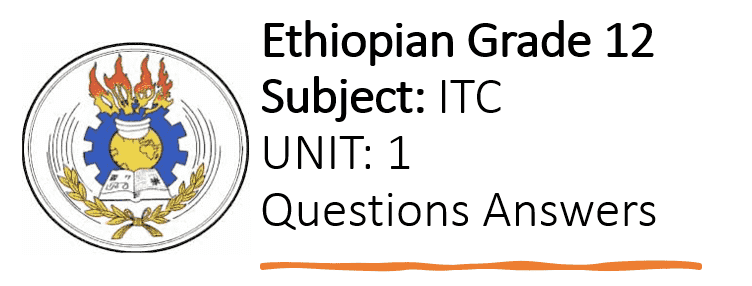Ethiopian Grade 12 ITC UNIT 1 Questions Answers (Information Systems) will help in EUEE (Grade 12) University Entrance written exam. Just try our Information and Communications Technology (ITC) sample multiple-choice question answers.
Electronic technologies are playing an important role in shaping the mindset of Ethiopian citizens, and they will want that mindset reflected in social governance. The Internet has changed the way of conducting business in many companies. As its influence grows and more companies use the Internet, the possibilities for conducting business-to-business commerce on the Internet will expand greatly and become more of a routine part of commerce than it is today. We have not yet reached that position where everyone thinks of conducting business-to-business commerce on the Internet every day, but we will.
Unit 1: Information Systems
- 1.1 Basics of E-learning.
- 1.2 Basics of E-Government
- 1.3 Basics of E-Banking
- 1.4 Basics of E-Libraries
- 1.5 Basics of E-Commerce.
- 1.6 System Analysis
Ethiopian Grade 12 ITC UNIT 1 Questions Answers
Q1. Which of the following not fall into E-learning categories?
- A) Knowledge Databases
- B) Asynchronous Training.
- C) Offline Support
- D) Synchronous Training.
Answer: C, When a computer or other device is not turned on or connected to other devices, it is said to be “offline.”
Q2. Which of the following technology used to store complex structured information used by a computer system?
- A) Knowledge Databases
- B) Asynchronous Training.
- C) Online Support
- D) Synchronous Training.
Answer: C, These are usually moderately interactive, meaning that you can either type in a keyword or phrase or search the database, or make a selection from an alphabetical list.
Q3. Which involves self-paced learning, either CD-ROM-based or e-mail.
- A) Knowledge Databases
- B) Asynchronous Training.
- C) Online Support
- D) Synchronous Training.
Answer: B, This is e-learning in the more traditional sense of the word
Q4. Who is the sole operator of all telecommunications-related services in Ethiopia?
- A) VSAT Satellite Broadband
- B) Mobile Satellite Broadband BGAN
- C) Thuraya IP
- D) Ethiopian Telecommunications Corporation (ETC)
Answer: D, The Ethiopian Telecommunications Corporation (ETC) is the sole operator of all telecommunications-related services including the provision of Internet and public phone in Ethiopia.
Q5. E-Learning can be done using _____
- A) an Internet connection,
- B) an intranet,
- C) storage disk
- D) All of the above.
Answer: D
Q6. What is Learning Management System?
- A) Knowledge Databases
- B) Software package
- C) Moodle
- D) All of the above
Answer: B A Learning Management System (or LMS) is a software package that enables the management and delivery of learning content and resources to students.
Q7. What is Moodle?
- A) Open Source Course Management System (CMS)
- B) Learning Management System (LMS)
- C) Virtual Learning Environment (VLE)
- D) All of the above
Answer: D, It has become very popular among educators around the world as a tool for creating online dynamic websites for their students. Moodle.org website (URL: www.moodle.org)
Q8. “E-government” refers to the use by government agencies of _________
- A) Open Source Course Management System (CMS)
- B) Learning Management System (LMS)
- C) Virtual Learning Environment (VLE)
- D) Information Technology
Answer: D,
Q9. Which of the following major functions does not provide by E-governance?
- A) e-administration
- B) e-citizens and e-service
- C) e-society
- D) e-learning
Answer: D
Q10. Which of the following is the major e-government initiative?
- A) WoredaNet Initiative
- B) EthioNet Initiative
- C) WorldNet Initiative
- D) EthioGovNet Initiative
Answer: C: This is a major e-government initiative that connects all 600 of Ethiopia’s local councils (woredas) to 11
regional capitals through Internet telephone and video-conferencing. WoredaNet is implemented by the Ethiopia Telecommunication Agency.
Q11. How many types of E-government services are there?
- A) two
- B) four
- C) six
- D) eight
Answer: B. There are four types of E-government services: Government-to-Citizen (G2C). Government-to-Business (G2B). Government-to-Employee (G2E). Government-to-Government (G2G).
Q12. Which national infrastructure is being established to connect the Federal Government with Regional and District level administration.
- A) Local Area Network
- B) Wide Are Newtok
- C) World Are Newtok
- D) All of the above.
Answer: B.
See also

